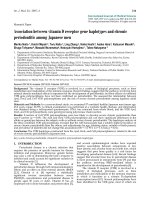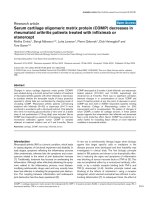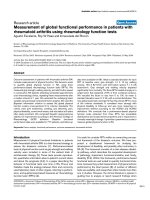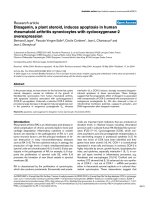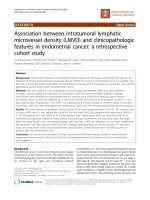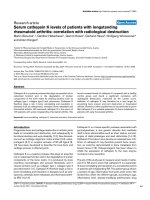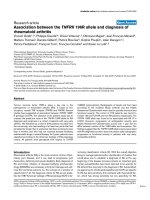Báo cáo y học: "Association between occupational exposure to mineral oil and rheumatoid arthritis: results from the Swedish EIRA case–control study" docx
Bạn đang xem bản rút gọn của tài liệu. Xem và tải ngay bản đầy đủ của tài liệu tại đây (147.12 KB, 8 trang )
Open Access
Available online />R1296
Vol 7 No 6
Research article
Association between occupational exposure to mineral oil and
rheumatoid arthritis: results from the Swedish EIRA case–control
study
Berit Sverdrup
1,2
, Henrik Källberg
3
, Camilla Bengtsson
3
, Ingvar Lundberg
4
, Leonid Padyukov
1
,
Lars Alfredsson
3,5
, Lars Klareskog
1
and the Epidemiological Investigation of Rheumatoid Arthritis
study group
1
Rheumatology Unit, Department of Medicine, Karolinska Institutet/Karolinska Hospital, Stockholm, Sweden
2
Rheumatology Unit, Eskilstuna Hospital, Eskilstuna, Sweden
3
Institute of Environmental Medicine, Karolinska Institutet, Stockholm, Sweden
4
Department of Occupational Medicine, National Institute for Working Life, Stockholm, Sweden
5
Stockholm Center for Public Health, Stockholm County Council, Stockholm, Sweden
Corresponding author: Lars Klareskog,
Received: 28 Jun 2005 Revisions requested: 29 Jul 2005 Revisions received: 18 Aug 2005 Accepted: 24 Aug 2005 Published: 23 Sep 2005
Arthritis Research & Therapy 2005, 7:R1296-R1303 (DOI 10.1186/ar1824)
This article is online at: />© 2005 Sverdrup et al.; licensee BioMed Central Ltd.
This is an Open Access article distributed under the terms of the Creative Commons Attribution License ( />2.0), which permits unrestricted use, distribution, and reproduction in any medium, provided the original work is properly cited.
Abstract
The aim of the present study was to investigate the association
between exposure to mineral oil and the risk of developing
rheumatoid arthritis (RA), and in addition to perform a separate
analysis on the major subphenotypes for the disease; namely,
rheumatoid factor (RF)-positive RA, RF-negative RA,
anticitrulline-positive RA and anticitrulline-negative RA,
respectively. A population-based case–control study of incident
cases of RA was performed among the population aged 18–70
years in a defined area of Sweden during May 1996–December
2003. A case was defined as an individual from the study base
who for the first time received a diagnosis of RA according to
the American College of Rheumatology criteria of 1987.
Controls were randomly selected from the study base with
consideration taken for age, gender and residential area. Cases
(n = 1,419) and controls (n = 1,674) answered an extensive
questionnaire regarding lifestyle factors and occupational
exposures, including different types of mineral oils. Sera from
cases and controls were investigated for RF and anticitrulline
antibodies.
Among men, exposure to any mineral oil was associated with a
30% increased relative risk of developing RA (relative risk = 1.3,
95% confidence interval = 1.0–1.7). When cases were
subdivided into RF-positive RA and RF-negative RA, an
increased risk was only observed for RF-positive RA (relative risk
= 1.4, 95% confidence interval 1.0–2.0). When RA cases were
subdivided according to the presence of anticitrulline
antibodies, an increased risk associated with exposure to any
mineral oil was observed only for anticitrulline-positive RA
(relative risk = 1.6, 95% confidence interval = 1.1–2.2). Analysis
of the interaction between oil exposure and the presence of
HLA-DR shared epitope genes regarding the incidence of RA
indicated that the increased risk associated with exposure to
mineral oil was not related to the presence of shared epitope
genotypes.
In conclusion, our study shows that exposure to mineral oil is
associated with an increased risk to develop RF-positive RA and
anticitrulline-positive RA, respectively. The findings are of
particular interest since the same mineral oils can induce
polyarthritis in rats.
Introduction
Rheumatoid arthritis (RA) is a disease that is dependent on
genetic factors as well as environmental factors, as seen from
both concordance data in twins and from a number of epide-
miological and genetic studies [1,2]. Whereas knowledge on
the genetic basis of this disease is rapidly advancing [3,4],
there is a scarcity of data on environmental agents that may
cause arthritis [5-7]. In particular, very little information exists
anti-CP = antibodies to citrulline-containing peptides; CI = confidence interval; EIRA = Epidemiological Investigation of Rheumatoid Arthritis; ELISA
= enzyme-linked immunosorbent assay; PCR = polymerase chain reaction; RA = rheumatoid arthritis; RF = rheumatoid factor; RR = relative risk; SE
= shared epitope.
Arthritis Research & Therapy Vol 7 No 6 Sverdrup et al.
R1297
in humans on environmental risk factors with a capacity to
induce arthritis in experimental arthritis systems.
Agents that are able to induce experimental arthritis in animals,
particularly rodents, include a number of adjuvants originating
from many different sources, including bacteria, yeast, viruses
and mineral oils. Several models thus exist where rodents with
certain genetic backgrounds develop arthritis after being
exposed to nonimmunogenic adjuvants intracutaneously [8,9]
or even percutaneously [10,11]. The exact mechanisms
involved in the pathogenesis of these adjuvant arthritis models
are still not completely understood, but we know that the adju-
vants/mineral oils can activate cells within the lymph nodes
without causing any simultaneous apparent inflammatory reac-
tion in the skin [10]. Whether similar mechanisms (i.e. polyar-
thritis induced by simple adjuvants) are also operative in
human arthritis is an open issue, although case reports exist on
the occurrence of arthritis after immunization with Bacillus Cal-
mette–Guerin [12,13], which is known to contain adjuvants
able to cause arthritis in rodents [14].
In order to investigate the possible relationship between the
occurrence of RA and the exposure to a series of different
environmental agents, including simple adjuvants, we are cur-
rently performing a large population-based case–control study
in Sweden using incident cases of RA. In the present report,
we investigate the association between exposure to various
mineral oils and the risk of developing RA.
Materials and methods
The present study is a population-based case–control study of
incident cases of RA among the population aged 18–70 years
living in a geographically defined area in the middle part and
southern part of Sweden during the period May 1996–
December 2003. Ethical permission was obtained from rele-
vant ethical committees and all the participants (cases as well
as controls) consented to contribute to the study.
Case identification
A case was defined as a person in the study base who for the
first time received a diagnosis of RA according to the Ameri-
can College of Rheumatology criteria of 1987 [15]. As
described previously [16], all potential cases were examined
and diagnosed by a rheumatologist at the unit entering the
case into the study. All rheumatology units linked to the gen-
eral welfare system in the study area participated in the study,
as well as almost all of the, very few, privately-run rheumatol-
ogy units. In total there were 19 reporting clinics, 15 of which
were 'Early Arthritis Clinics' [17]. At the start some centres
also reported cases that did not satisfy the criteria in order to
enable investigations of undifferentiated arthritis, but these
subjects were eventually excluded from the study.
Analysis of rheumatoid factor (RF) was performed locally and
reported as RF-positivity or RF-negativity. The RF levels were
determined and the cutoff value was set to 20.
Selection of controls
For each potential case a control was randomly selected from
the study base with consideration taken for age, gender and
residential area. The selection of controls was conducted
using the national population register, which is continuously
updated. If a control declined to participate, was not traceable
or reported having RA, a new control was selected using the
same principles (see also [16]). Controls belonging to cases
excluded due to not fulfilling the American College of Rheuma-
tology criteria remained in the study.
Data collection
Information about environmental exposures was collected by
an identical questionnaire given to the cases shortly after they
had been informed about the RA diagnosis and sent by mail to
the controls. All questionnaires were supposed to be
answered at home.
Unanswered or incompletely answered questionnaires were
completed by mail or by telephone by purpose-trained persons
not connected to the rheumatology clinics. This was carried
out in an identical way for the case and control groups. In total,
1,480 cases and 2,038 controls were identified. Of these,
1,419 cases (1,012 women and 407 men) and 1,674 controls
(1,188 women and 486 men) participated in the study, giving
a participation rate of 96% for cases and a participation rate
of 82% for controls.
Exposure
The questionnaire contains questions within a wide spectrum
regarding personal circumstances, including lifestyle factors,
occupational exposures, health aspects, socioeconomic fac-
tors and demographic data. Specific questions were asked
about occupational exposure to cutting oil, motor oil, form oil,
hydraulic oil and asphalt, respectively. This enabled the classi-
fication of cases and controls with regard to ever having been
occupationally exposed to each of these mineral oils, respec-
tively. Subjects who reported exposure to any of these mineral
oils were classified as exposed to any mineral oil.
For each case the time point at which symptoms giving suspi-
cion of RA started was used as an estimation of the disease
onset. The year in which this time point occurred was defined
as the index year. The same index year was used for the corre-
sponding control. Only data on exposures up to the index year
have been analysed in the present study.
Detection of antibodies to citrulline-containing peptides
Antibodies to citrulline-containing peptides (anti-CP) were
analysed with the Immunoscan-RA Mark2 ELISA test (see
[18]). A level above 25 U/ml was regarded as positive
Available online />R1298
according to instructions in the kit and validation at the clinical
immunology laboratory in Uppsala. The kit uses cyclic citrulli-
nated peptides as the substrate, and sera reacting positively
with this kit are, in the present paper, defined as having signif-
icant antibody titres against citrullinated peptides (anti-CP
+
)
Genotyping
DNA from ethylenediaminetetraacetic acid blood was
extracted using the sequence-specific primer PCR method
[19]. Among the HLA-DRB1 genes, DRB1*01, DRB1*04 and
DRB1*10 were defined as 'shared epitope (SE) genes' [3,4].
At the beginning of the study, individuals from part of the mate-
rial (81 cases) were subtyped for identification of HLA-
DRB1*01 and HLA-DRB1*04 alleles. We determined 89%
frequency of the DRB1*0101 allele and 98% frequency of the
DRB1*0401 + DRB1*0404 + DRB1*0405 + DRB1*0408
alleles. For practical reasons the genotyping was restricted to
only DR low-resolution analysis.
Potential confounding factors
All results were adjusted for age and residential area accord-
ing to the principle of control selection. In the analyses, age
was categorised into 10 strata (18–24, 25–29, 30–34, 35–
39, 40–44, 45–49, 50–54, 55–59, 60–64 and 65–70 years
of age). Smoking and occupational class could also be consid-
ered as potential confounding factors. Smoking was catego-
rised into two strata (never smokers and ever smokers) and
occupational class was categorised into seven strata
(unskilled manual workers, skilled manual workers, assistant
non-manual employees, intermediate non-manual employees,
higher non-manual employees, self-employed and farmers).
Statistical analysis
Subjects who had been exposed to different mineral oils were
compared with subjects unexposed to any mineral oil with
regard to the incidence of RF
+
RA, RF
-
RA, anti-CP
+
RA, anti-
CP
-
RA and RA overall, respectively, by calculating the odds
ratio with the 95% confidence interval (CI). We performed
matched analyses as well as unmatched analyses of the data.
Odds ratios were adjusted for potential confounding by means
Table 1
Relative risk for developing RF-positive or RF-negative RA in men exposed to mineral oils
Outcome Oil Exposed cases/
controls (n)
a
Relative risk
b
95% confidence
interval
Relative risk
c
95% confidence
interval
Total RA Cutting fluid 36/39 1.1 0.7–1.9 1.1 0.7–1.8
Motor oil 84/84 1.2 0.9–1.8 1.2 0.9–1.8
Hydraulic oil 83/72 1.4 1.0–2.1 1.4 1.0–2.0
Form oil 25/24 1.3 0.7–2.5 1.3 0.7–2.4
Asphalt 13/14 1.3 0.6–2.8 1.2 0.6–2.7
Any mineral oil 135/132 1.3 1.0–1.7 1.3 1.0–1.7
RF
+
RA Cutting fluid 29/39 1.4 0.8–2.5 1.4 0.8–2.4
Motor oil 60/84 1.4 0.9–2.1 1.4 0.9–2.1
Hydraulic oil 56/72 1.6 1.0–2.3 1.5 1.0–2.3
Form oil 20/24 1.7 0.9–3.3 1.7 0.9–3.2
Asphalt 9/14 1.4 0.6–3.5 1.4 0.6–3.4
Any mineral oil 96/132 1.5 1.0–2.0 1.4 1.0–2.0
RF
-
RA Cutting fluid 7/39 0.6 0.2–1.4 0.6 0.2–1.4
Motor oil 24/84 0.9 0.6–1.6 0.9 0.5–1.6
Hydraulic oil 27/72 1.2 0.7–2.1 1.2 0.7–2.1
Form oil 5/24 0.6 0.2–1.8 0.6 0.2–1.8
Asphalt 4/14 0.9 0.3–3.0 0.9 0.3–3.0
Any mineral oil 39/132 1.0 0.6–1.5 1.0 0.6–1.5
Relative risk and 95% confidence interval for developing rheumatoid factor (RF)-positive rheumatoid arthritis (RA), RF
-
RA and RA overall (total
RA) for men 18–70 years old exposed to different kinds of mineral oils compared with unexposed men.
a
RF status unknown for one unexposed case.
b
Adjusted for age and residential area.
c
Adjusted for age, residential area and smoking.
Arthritis Research & Therapy Vol 7 No 6 Sverdrup et al.
R1299
of conditional logistic regression in the matched analyses and
by means of unconditional logistic regression in the
unmatched analyses. We only present results from the
unmatched analyses as these were in close agreement with
those from the matched analyses but, in general, had higher
precision. Odds ratios were interpreted as the relative risk
(RR) because the study was population based. Results for
women and men were analysed separately. Estimates of RR
were adjusted for potential confounding from age, gender, res-
idential area and smoking. Further adjustment for occupational
class only marginally changed the estimates and was not
retained in the final analyses.
The presence of HLA-DR SE genes is a risk factor for RF
+
RA
and anti-CP
+
RA, but not for either RF
-
RA or anti-CP
-
RA
[20,21]. It is thus of interest to investigate the possibility of a
gene–environment interaction between SE genes and expo-
sure to mineral oil regarding the incidence of RF
+
RA and anti-
CP
+
RA, respectively. Interaction between the genotype and
mineral oil was evaluated using departure from the additivity of
effects as a criterion of interaction, as suggested by Rothman
and colleagues [22]. To quantify the amount of interaction, the
attributable proportion due to interaction was calculated
together with the 95% CI [23]. The attributable proportion due
to interaction, which takes a value between 0 and 1, is the pro-
portion of the incidence among persons exposed to two inter-
acting factors that is attributable to the interaction per se (i.e.
reflecting their joint effect beyond the sum of their independ-
ent effects). A potential interaction between smoking and min-
eral oil was also evaluated. All analyses were performed using
the Statistical Analysis System (version 8.2; SAS Institute,
Stockholm, Sweden).
Results
Of a total of 1,419 cases in this study, 1,012 were women and
407 were men (mean age at inclusion of 50 and 53 years,
respectively). A total 65.5% of the female cases and 66.3% of
the male cases were RF
+
. The mean duration of disease at
inclusion in the study was 10 months. Only men reported a
Table 2
Relative risk for developing anti-CP-positive RA or anti-CP-negative RA for men exposed to mineral oils
Outcome Oil Exposed cases/
controls (n)
Relative risk
a
95% confidence
interval
Relative risk
b
95% confidence
interval
Anti-CP
+
RA Cutting fluid 28/39 1.6 0.9–2.7 1.5 0.8–2.6
Motor oil 57/84 1.5 1.0–2.2 1.5 1.0–2.3
Hydraulic oil 56/72 1.8 1.2–2.7 1.7 1.1–2.6
Form oil 16/24 1.5 0.7–2.9 1.4 0.7–2.9
Asphalt 10/14 1.6 0.7–3.9 1.5 0.6–3.7
Any mineral oil 93/132 1.6 1.1–2.2 1.6 1.1–2.2
Anti-CP
-
RA Cutting fluid 8/39 0.6 0.2–1.3 0.6 0.2–1.3
Motor oil 27/84 0.9 0.6–1.5 0.9 0.6–1.5
Hydraulic oil 27/72 1.0 0.6–1.7 1.0 0.6–1.7
Form oil 9/24 1.1 0.5–2.6 1.1 0.5–2.6
Asphalt 3/14 0.7 0.2–2.6 0.7 0.2–2.6
Any mineral oil 42/132 1.0 0.6–1.5 1.0 0.6–1.5
Relative risk and 95% confidence interval for developing antibodies to citrulline-containing peptides (anti-CP)-positive rheumatoid arthritis (RA)
and anti-CP
-
RA for men 18–70 years old exposed to different kinds of mineral oils compared with unexposed men.
a
Adjusted for age and residential area.
b
Adjusted for age, residential area and smoking.
Figure 1
Relative risk of anti-CP-positive RA with mineral exposure and different expression of SE genesRelative risk of anti-CP-positive RA with mineral exposure and different
expression of SE genes. The relative risk (RR) of developing rheumatoid
arthritis (RA) positive for antibodies to citrulline-containing peptides
(anti-CP) with mineral exposure and shared epitope (SE) genes com-
pared with unexposed subjects with SE genes is 1.4, with 95% confi-
dence interval = 0.8–2.4. The corresponding risk among subjects with
no SE gene is 1.5, with 95% confidence interval = 0.6–3.9.
0
1
2
3
4
RR
SE
No
mineral oil
Mineral
oil
No SE
No
mineral oil
Mineral
oil
Available online />R1300
substantial occupational exposure to mineral oils (in total 135
cases and 132 controls), with occupational exposure to min-
eral oils uncommon among women (21 cases and 21 con-
trols). Only men were retained in the further analysis. Among
these men, motor oil (84 cases and 84 controls) and hydraulic
oil (83 cases and 72 controls) were the most common
exposures.
Exposure to any mineral oil was associated with a 30%
increased risk of developing RA (RR = 1.3, 95% CI = 1.0–1.7)
(Table 1). When cases were subdivided into RF
+
RA and RF
-
RA, an increased risk was only observed for RF
+
RA (RR = 1.4,
95% CI = 1.0–2.0). The same pattern with a higher RR asso-
ciated with RF
+
RA was observed for all of the specific mineral
oils. The RR of developing RF
+
RA associated with exposure
to hydraulic oil was 1.5 (95% CI = 1.0–2.3).
We also investigated the relationship between exposure to dif-
ferent oils and the incidence of anti-CP
+
RA and anti-CP
-
RA,
respectively (Table 2). Exposure to any mineral oil was associ-
ated with a 60% increased risk of anti-CP
+
RA (RR = 1.6, 95%
CI = 1.1–2.2). Higher RR associated with anti-CP
+
RA as
compared with anti-CP
-
RA was seen for all the specific min-
eral oils. The RR of developing anti-CP
+
RA associated with
exposure to hydraulic oil was 1.7 (95% CI = 1.1–2.6), and that
for motor oil was 1.5 (95% CI = 1.0–2.3).
In the analysis, adjustment was made according to age, resi-
dential area and smoking. The results after adjustment for
smoking were almost identical to those not adjusted for smok-
ing (Tables 1 and 2).
The presence of HLA-DR SE genes is a risk factor for RF
+
RA
and anti-CP
+
RA, but not for either RF
-
RA or anti-CP
-
RA
[20,21]. When we analysed the possibility of a gene–environ-
ment interaction between SE genes and exposure to mineral
oil regarding the incidence of RF
+
RA and anti-CP
+
RA,
respectively, no strong evidence of such an interaction was
found (Table 3 and Fig. 1). The attributable proportion due to
the interaction between SE genes and mineral oil was 0.2
(95% CI = -0.2-0.6) regarding RF
+
RA as well as regarding
anti-CP
+
RA.
When a potential interaction between smoking and mineral
oils was analysed, a tendency towards such an interaction was
noted but a firm conclusion was hampered by the small num-
bers (regarding anti-CP
+
RA, the attributable proportion due to
interaction was 0.5 [95% CI = -0.2-1.2]).
Table 3
Relative risk for RA with different combinations of mineral oil exposure and shared epitope genes
Outcome Exposure to
mineral oil
No shared epitope Any shared epitope
Cases/controls
(n)
a
Relative risk
b
95%
confidence
interval
Cases/controls
(n)
a
Relative risk
b
95%
confidence
interval
RF
+
RA No 28/89 1.0
c
128/88 4.7 2.8–8.0
Yes 17/43 1.2 0.6–2.5 73/38 6.4 3.4–11.8
RF
-
RA No 32/89 1.0
c
63/88 2.1 1.2–3.6
Yes 10/43 0.7 0.3–1.5 25/38 2.1 1.1–4.2
Total RA No 60/89 1.0
c
191/88 3.2 2.1–4.9
Yes 27/43 0.9 0.5–1.7 98/38 3.9 2.3–6.6
Anti-CP
+
RA No 18/89 1.0
c
126/88 8.0 4.4–14.7
Yes 13/43 1.6 0.7–3.7 75/38 11.1 5.6–22.1
Anti-CP
-
RA No 42/89 1.0
c
65/88 1.5 0.9–2.5
Yes 14/43 0.7 0.3–1.5 23/38 1.5 0.7–2.9
Total RA No 60/89 1.0
c
191/88 3.2 2.1–4.9
Yes 27/43 0.9 0.5–1.7 98/38 3.9 2.3–6.6
Relative risk and 95% confidence interval for developing rheumatoid factor (RF)-positive rheumatoid arthritis (RA), RF
-
RA, antibodies to citrulline-
containing peptides (anti-CP)-positive RA, anti-CP
-
RA and total RA for men with different combinations of exposure to mineral oil and shared
epitope genes compared with men unexposed to any mineral oil and lacking shared epitope genes.
a
Data on the shared epitope are missing for 10 cases and 51 controls exposed to mineral oil, and for 21 cases and 176 controls unexposed to
mineral oil (in comparison with Tables 1 and 2).
b
Relative risk adjusted for age, residential area and smoking.
c
Reference group.
Arthritis Research & Therapy Vol 7 No 6 Sverdrup et al.
R1301
Discussion
According to the results of this study, males exposed to vari-
ous mineral oils in their profession appear to have an
increased risk of developing RA. This observation is of interest
in the search for aetiological factors of importance for trigger-
ing RA, as exposure to the same kinds of oils have been shown
to induce polyarthritis with large similarities to RA in rodents
[8,9].
This study has the advantage of being a population-based
case–control study using only incident cases of new diag-
nosed RA, fulfilling the American College of Rheumatology cri-
teria, assessed by a specialist in rheumatology. All
rheumatology units linked to the general welfare system in the
study area reported cases to the study, as did privately-run
rheumatology units [17]. Cases received their questionnaire in
connection with inclusion into the study at each study centre
(i.e. in connection with the time point of the RA diagnosis),
whereas the controls received their questionnaires by mail. All
questionnaires were supposed to be answered at home. Both
cases and controls returned their questionnaire by mail to the
study secretariat at the Karolinska Institutet. It is unlikely that
the differential distribution process of the questionnaire to
cases and to controls, respectively, led to any important differ-
ence regarding the quality of exposure information.
A possible disadvantage with a case–control study with retro-
spective collection of exposure data is the risk for misclassifi-
cation of exposure due to a recall bias that differs between
cases and controls. Only subjects that received a diagnosis of
RA for the first time were included in order to reduce the risk
for recall bias, the mean duration between the estimated dis-
ease onset and inclusion into the study was 10 months, and
analyses of data of environmental exposures were only per-
formed up to the index year. Bias due to change in habits, job
or work exposure as a result of the disease was therefore
probably limited. In order to investigate whether misclassifica-
tion of exposure to mineral oils differed between cases and
controls, an industrial hygienist performed an independent
classification based on information regarding occupation and
the branch of industry during the period of the stated exposure
to mineral oils. The industrial hygienist was blinded with regard
to the disease status of the individuals. According to the result
of this investigation a similar proportion (15% and 20%) of
cases and controls seemed to be false positive with regard to
exposure to mineral oils. The assessment made by the hygien-
ist should not be regarded as more qualified than the assess-
ment made by the subjects. However, the marked and similar
correspondence of the hygienist's assessment and the sub-
jects' statements among cases and controls, respectively,
suggests that differential misclassification of exposure has
probably not biased the estimated RR to any great extent. The
response rate in the study was high, with 96% for cases and
82% for controls, which limits risk for selection bias in this
stage.
All results were adjusted for age and residential area accord-
ing to the principle of control selection. In the analysis, we
investigated the potential confounding from smoking.
Adjustment for smoking only marginally changed the esti-
mated RR (Tables 1 and 2). Hence, differences regarding
smoking habits do not explain the observed association
between exposure to mineral oils and the risk of RA. When a
potential interaction between smoking and mineral oils was
analysed, a tendency towards such an interaction was noted,
but the observation was based on a small number.
According to the results of our study, mineral oils (in particular,
hydraulic oil and motor oil) appear to be associated with a par-
ticular high risk of RF
+
RA and anti-CP
+
RA. Bearing in mind
the relatively small number of exposed men, however, caution
is warranted regarding any far-reaching conclusion about par-
ticular mineral oils.
Previously, to our knowledge, only one study has investigated
the relationship between exposure to mineral oils and the
development of RA [24]. This is notable, since mineral oils
have been very well documented as arthritogenic agents in
rodents [8]. The administration of mineral oils, therefore, both
intracutaneously as one single injection and percutaneously in
multiple exposures, has been shown to induce an erosive and
RA-like polyarthritis in certain strains of rats, in particular the
DA rat strain [10,11].
Our results confirm those of previous studies that the pres-
ence of HLA-DR SE genes is a risk factor for anti-CP
+
RA and
RF
+
RA but not for either anti-CP
-
RA or RF
-
RA [20,21]. Anal-
ysis of a possible interaction between the SE genes and expo-
sure to mineral oils did not reveal any significant interaction
between exposure to mineral oil and the presence of HLA-DR
SE genes. Although based on small numbers of observations,
this suggests that mechanisms responsible for the association
between mineral oil exposure and RA may be different from
those responsible for the association between smoking and
RA, where a pronounced interaction between smoking and the
HLA-DR SE genes was observed [20,21].
The potential molecular pathogenesis of polyarthritis associ-
ated with exposure to mineral oil is difficult to speculate on. It
is known in experimental animals, however, that oils and other
adjuvants confer their activation of the immune system mainly
in the lymph nodes, without leaving any signs of inflammation
in the exposed skin [11,25-28]. Here, an initial activation of the
innate immune system subsequently leads to the activation
also of T-cell immunity, in such a way that the T cells can sub-
sequently transfer the disease to naive animals [29]. It is also
known in rodents that susceptibility to adjuvant-induced arthri-
tis, including oil-induced disease, is highly dependent on the
genetic constitution of the exposed animals [26]. It is thus pos-
sible that humans with a genetic constitution similar to the
adjuvant-susceptible rodents would also have a particularly
Available online />R1302
high susceptibility for mineral-oil associated arthritis. This
question may soon be possible to investigate further if precise
polymorphic genes associated with susceptibility to adjuvant
arthritis in rodents are identified, and indications that such
genes exist have already been provided [30].
It is thus possible to hypothesise that adjuvant stimulus of the
innate immune system, taking place in genetically susceptible
human beings, would trigger the activation of a cascade of
events involving activated T lymphocytes, and that these
events for as yet unknown reasons finally result in inflammatory
joint disease. In this context it is of interest that the association
between RA and exposure to mineral oil does not appear to be
related to the presence or absence of HLA-DR SE genes in
the mineral-exposed individuals. In conjunction with another
environmental exposure – smoking – a major interaction was
seen between smoking and the presence of HLA-DR SE. This
interaction has been suggested to depend on the capacity of
smoke to induce an aberrant citrullination of proteins in the
lungs of long-term smokers, something that may trigger anti-
CP immunity in individuals carrying HLA-DR SE genes [21].
The present demonstration of an exposure not linked to the
presence of HLA-DR SE genes indicates a complex pattern of
interactions between several environmental triggers, several
genetic features and, eventually, several patterns of immunore-
activities in the pathogenesis of RA. If these different patterns
in humans can be linked to different rodent models of arthritis
– as is suggested from the findings in the present paper – we
may be able to use knowledge of molecular pathogenesis and
targeted therapies gained in different animal systems to
develop a better understanding of both pathogenesis and
treatment of relevant subgroups of the human disease.
Conclusion
The present study shows that exposure to an environmental
agent capable of inducing an RA-like polyarthritis in rodents –
mineral oil – is associated with an increased risk for RF
+
RA
and anti-CP
+
RA in man. Further exploration of this finding may
be of interest in elucidating whether other types of adjuvants,
such as microbial agents and other occupational agents, can
also act as arthritis-inducing agents in humans, and to further
link the molecular pathogenesis of adjuvant-associated arthri-
tis in rodents with adjuvant-induced arthritis in man.
Competing interests
The author(s) declare that they have no competing interests.
Authors' contributions
BS contributed to the design of the study, and the interpreta-
tion and writing of the manuscript. HK performed a major part
of the biostatistics work and contributed to the interpretation
of results and the writing of the manuscript. CB contributed to
the design of the study, to the collection of the data, to statis-
tical analysis and to the writing of the manuscript. IL contrib-
uted to the design of the study and to the interpretation of the
results. LP had the main responsibility for the genetic analyses
and contributed to the analysis and interpretation of the
results. LA and LK were responsible for the overall design of
the Epidemiological Investigation of Rheumatoid Arthritis
study, for the analysis of data and for the final writing of the
manuscript. All authors read and approved the final text before
submission of the manuscript.
Acknowledgements
The authors wish to thank Marie-Louise Serra (Institute of Environmental
Medicine at Karolinska Institutet, Stockholm, Sweden) for excellent
assistance in the collection of data and to thank Lena Nise (Institute of
Environmental Medicine at Karolinska Institutet, Stockholm, Sweden) for
data analysis. The study was supported by grants from the Swedish
Medical Research Council, from the Swedish Council for Working life
and Social Research, from the King Gustaf V's 80-year foundation, from
the Swedish Rheumatism Foundation, from Stockholm County Council,
from the Söderberg Foundation and from the insurance company AFA.
The Epidemiological Investigation of Rheumatoid Artrhitis study group
consists of: Ingeli Andréasson, Landvetter; Eva Baecklund, Akademiska
Hospital; Ann Bengtsson and Thomas Skogh, Linköping Hospital; Johan
Bratt and Ingiäld Hafström, Karolinska University Hospital, Huddinge;
Jan Cedergren and Ethel Nilsson, Norrköping Hospital; Kjell Huddénius,
Rheumatology Clinic in Stockholm City; Shirani Jayawardene, Bollnäs
Hospital; Ann Knight, Hudiksvall Hospital; Ido Leden, Kristianstad Hos-
pital; Thomas Lerndal and Göran Lindahl, Danderyd Hospital; Bengt Lin-
dell, Kalmar Hospital; Christin Lindström and Gun Sandahl,
Sophiahemmet; Björn Löfström, Katrineholm Hospital; Birgitta Nord-
mark, Karolinska University Hospital, Solna; Ingmar Petersson, Spen-
shult Hospital; Christoffer Schaufelberger, Sahlgrenska University
Hospital; Patrik Stolt, Västerås Hospital; Berit Sverdrup, Eskilstuna Hos-
pital; Olle Svernell, Västervik Hospital; and Tomas Weitoft, Gävle
Hospital.
References
1. Rooney BK, Silman AJ: Epidemiology of the rheumatic
diseases. Curr Opin Rheumatol 1999, 11:91-97.
2. MacGregor AJ, Snieder H, Rigby AS, Koskenvuo M, Kaprio J, Aho
K, Silman AJ: Characterizing the quantitative genetic contribu-
tion to rheumatoid arthritis using data from twins. Arthritis
Rheum 2000, 43:30-37.
3. Gregersen PK, Silver J, Winchester RJ: The shared epitope
hypothesis. An approach to understanding the molecular
genetics of susceptibility to rheumatoid arthritis. Arthritis
Rheum 1987, 30:1205-1213.
4. Jawaheer D, Gregersen PK: Rheumatoid arthritis. The genetic
components. Rheum Dis Clin North Am 2002, 28:1-15.
5. Symmons DP, Bankhead CR, Harrison BJ, Brennan P, Barrett EM,
Scott DG, Silman AJ: Blood transfusion, smoking and obesity
as risk factors for the development of rheumatoid arthritis:
results from a primary care-based incident case-control study
in Norfolk, England. Arthritis Rheum 1997, 40:1955-1961.
6. Uhlig T, Hagen KB, Kvien TK: Current tobacco smoking, formal
education and the risk of rheumatoid arthritis. J Rheumatol
1999, 26:47-54.
7. Karlson EW, Lee IM, Cook NR, Manson JE, Buring JE, Hennekens
CH: A retrospective cohort study of cigarette smoking and risk
of rheumatoid arthritis in female health professionals. Arthritis
Rheum 1999, 42:910-917.
8. Kleinau S, Erlandsson H, Holmdahl R, Klareskog L: Adjuvant oils
induce arthritis in the DA rat. I. Characterization of the disease
and evidence for an immunological involvement. J Autoimmun
1991, 4:871-880.
Arthritis Research & Therapy Vol 7 No 6 Sverdrup et al.
R1303
9. Cannon GW, Woods ML, Clayton F, Griffiths MM: Induction of
arthritis in DA rats by incomplete Freund's adjuvant. J
Rheumatol 1993, 20:7-11.
10. Kleinau S, Erlandsson H, Klareskog L: Percutaneous exposure of
adjuvant oil causes arthritis in DA rats. Clin Exp Immunol 1994,
96:281-284.
11. Sverdrup B, Klareskog L, Kleinau S: Common commercial cos-
metic products induce arthritis in the DA rat. Environ Health
Perspect 1998, 106:27-32.
12. Torisu M, Miyahara T, Shinohara N, Ohsato K, Sonozaki H: A new
side effect of BCG immunotherapy – BCG-induced arthritis in
man. Cancer Immunol Immunother 1978, 5:77-83.
13. Hughes RA, Allard SA, Maini RN: Arthritis associated with adju-
vant mycobacterial treatment for carcinoma of the bladder.
Ann Rheum Dis 1989, 48:432-434.
14. Waksman BH, Pearson CM, Sharp JT: Studies of arthritis and
other lesions induced in rats by injection of mycobacterial
adjuvant. II. Evidence that the disease is a disseminated
immunological response to exogenous antigen. J Immunol
1960, 85:403-417.
15. Arnett FC, Edworthy SM, Bloch DA, McShane DJ, Fries JF, Cooper
NS, Healey LA, Kaplan SR, Liang MH, Luthra HS, et al.: The Amer-
ican Association 1987 revised criteria for the classification of
rheumatoid arthritis. Arthritis Rheum 1988, 31:315-324.
16. Stolt P, Bengtsson C, Nordmark B, Lindblad S, Lundberg I,
Klareskog L, Alfredsson L, the EIRA study group: Quantification
of the influence of cigarette smoking on rheumatoid arthritis:
results from a population based case–control study, using
incident cases. Ann Rheum Dis 2003, 62:835-841.
17. Klareskog L, Nordmark B, Lindblad S: On the organization of an
early arthritis clinic. Best Pract Res Clin Rheumatol 2001,
15:1-15.
18. Rönnelid J, Wick MC, Lampa J, Lindblad S, Nordmark B, Klareskog
L, van Vollenhoven R: Longitudinal analysis of anti-citrullinated
protein/peptide antibodies (anti-CP) during 5 years follow-up
in early rheumatoid arthritis: anti-CP status is a stable pheno-
type that predicts worse disease activity and greater radiolog-
ical progression. Ann Rheum Dis 2005 in press.
19. Olerup O, Zetterquist H: HLA-DR typing by PCR amplification
with sequence-specific primers (PCR-SSP) in 2 hours: an
alternative to serological DR typing in clinical practice includ-
ing donor-recipient matching in cadaveric transplantation. Tis-
sue Antigens 1992, 39:225-235.
20. Padyukov L, Silva C, Stolt P, Alfredsson L, Klareskog L: A gene–
environment interaction between smoking and shared epitope
genes in HLA-DR provides a high risk of seropositive rheuma-
toid arthritis. Arthritis Rheum 2004, 50:3085-3092.
21. Klareskog L, Stolt P, Lundberg K, Källberg H, Bengtsson C, Grune-
wald J, Rönnelid J, Erlandsson-Harris H, Ulfgren A-K, Rantapää-
Dahlqvist S, the EIRA study group, et al.: A new model for an eti-
ology of RA. Smoking may trigger HLA-DR (SE)-restricted
immune reactions to autoantigens modified by citrullination.
Arthritis Rheum 2005 in press.
22. Rothman KJ, Greenland S, Walker AM: Concepts of interaction.
Am J Epidemiol 1980, 112:467-470.
23. Hosmer DW, Lemeshow S: Confidence interval estimation of
interaction. Epidemiology 1992, 3:452-456.
24. Olsson A, Skogh T, Wingren G: Occupational determinants for
rheumatoid arthritis. Scand J Work Environ Health 2000,
26:243-249.
25. Kleinau S, Dencker L, Klareskog L: Oil-induced arthritis in DA
rats: tissue distribution of arthritogenic 14C-labelled
hexadecane. Int J Immunopharmacol 1995, 17:393-401.
26. Holmdahl R, Lorentzen JC, Lu S, Olofsson P, Wester L, Holmberg
J, Pettersson U: Arthritis induced in rats with nonimmunogenic
adjuvants as models for rheumatoid arthritis. Immunol Rev
2001, 184:184-202.
27. Holm BC, Svelander L, Bucht A, Lorentzen JC: The arthritogenic
adjuvant squalene does not accumulate in joints, but gives
rise to pathogenic cells in both draining and non-draining
lymph nodes. Clin Exp Immunol 2002, 127:430-435.
28. Mussener A, Klareskog L, Lorentzen J, Kleinau S: TNFα domi-
nates mRNA expression in lymphoid tissues of rats develop-
ing collagen- and oil-induced arthritis. Scand J Immunol 1995,
42:128-134.
29. Svelander L, Mussener A, Erlandsson-Harris H, Kleinau S: Poly-
clonal Th1 cells transfer oil-induced arthritis. Immunology
1997, 91:260-265.
30. Barton A, Eyre S, Myerscough A, Brintnell B, Ward D, Ollier WE,
Lorentzen JC, Klareskog L, Silman A, John S, Worthington J, Arthri-
tis Rheumatism Campaign National Repository: High resolution
linkage and association mapping identifies a novel rheuma-
toid arthritis susceptibility locus homologous to one linked to
two rat models of inflammatory arthritis. Hum Mol Genet 2001,
10:1901-1906.

